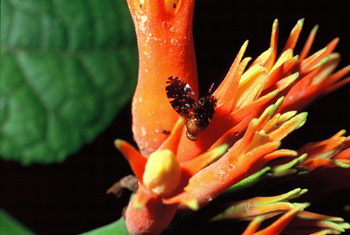Insect diversity in the tropics greater than previously believed
Insect diversity in the tropics greater than previously believed
mongabay.com
May 15, 2008
|
|
The tropics are more biodiverse than previously believed, report researchers writing in the journal Science.
Doing DNA analysis on Blepharoneura fruit flies in Latin America, biologists led by Cornell professor Marty Condon found a surprising number of different species occupying separate parts of the same plant. Many of these were “hidden” species, species that were both physically concealed within the plant and species that “hidden” in that they were nearly indistinguishable from other species without genetic analysis. In all the researchers identified 52 different species from 24 different host plants from the cucumber, sampled from an area spanning from Mexico to southern Bolivia and from the Pacific to Atlantic coasts.
Condon and colleagues found that while most of the fruit fly species were associated with a single host plant species, many of the plants hosted a range of insect species. One plant supported 13 species of fly.
 Widespread species of plants are hosts to multiple species of flies. Gurania spinulosa, a widespread species of plant, is host to thirteen species of flies. Shown here on a male flower of G. spinulosa: a female (with her ovipositor exerted) of one of the four species of Blepharoneura that infest male flowers in the Napo, Ecuador. Image courtesy of Marty Condon |
The researchers say they likely underestimated the actual number of fruit fly species for the sampled plants due to their sampling methodology and conservative criteria for the definition of a species.
“Although we report diversity exceeding the original morphological estimates by an order of magnitude, this must underrepresent the actual diversity of this group because our criterion for species delimitation is highly conservative,” the authors write. “As a result of this conservative criterion, we may be lumping biologically distinct species together, and single generalist species may actually represent multiple host-specific species.
“Also, our samples are limited; most of our collections were made during single trips, and our samples were restricted to species in fruit or flower at that time,” they continue. “Finally, the number of fly species recorded for a particular host plant species was most likely limited because the number of insect species detected rose as the number of collection localities increased.”
The researchers conclude that while host plant and niche diversity play a significant role in fruit fly diversity, geographical factors and the passage of time may play a more important role.
CITATION:
M.A. Cordon et al (2008). “Hidden Neotropical Diversity: Greater Than the Sum of Its Parts.” Science 16 May 2008
This article is based on news releases from Science and Cornell College